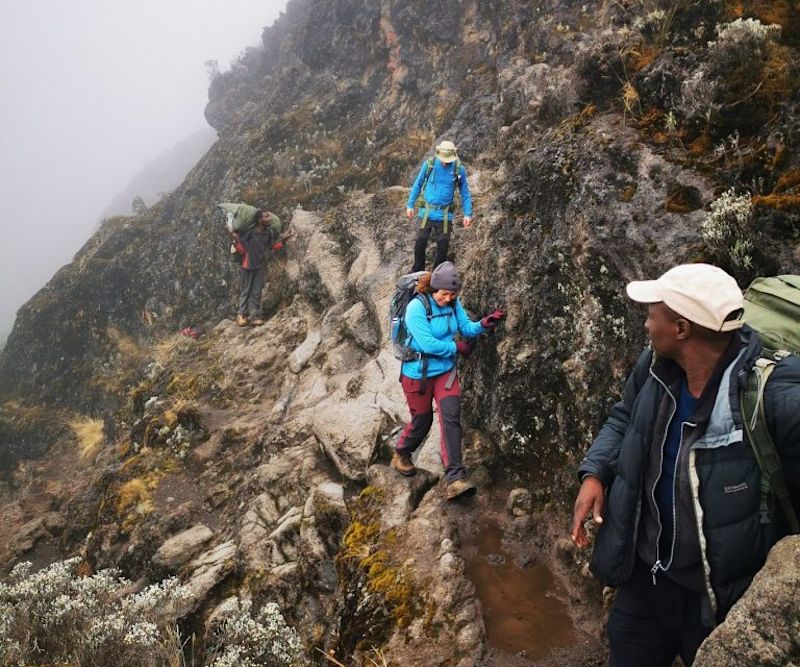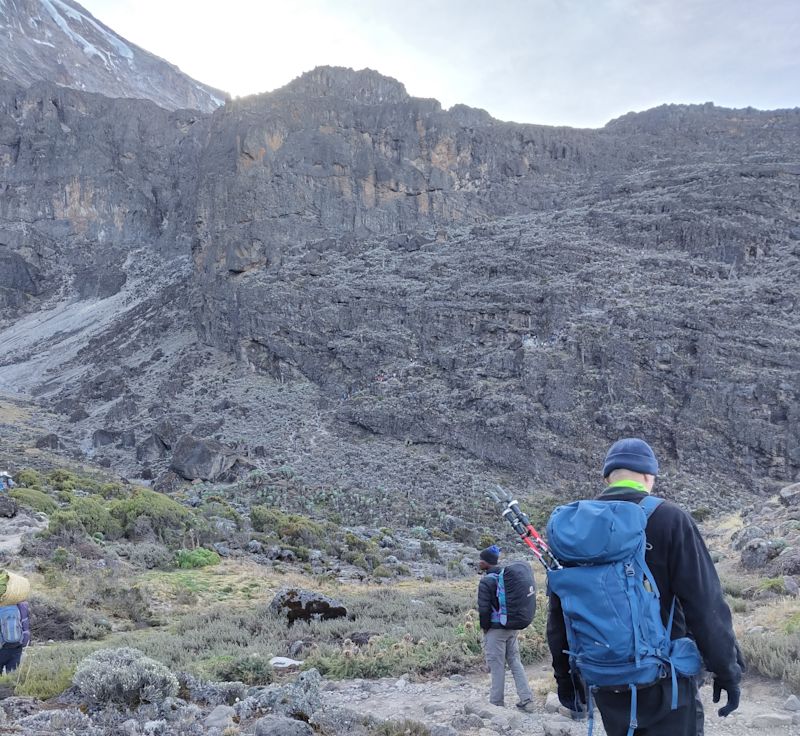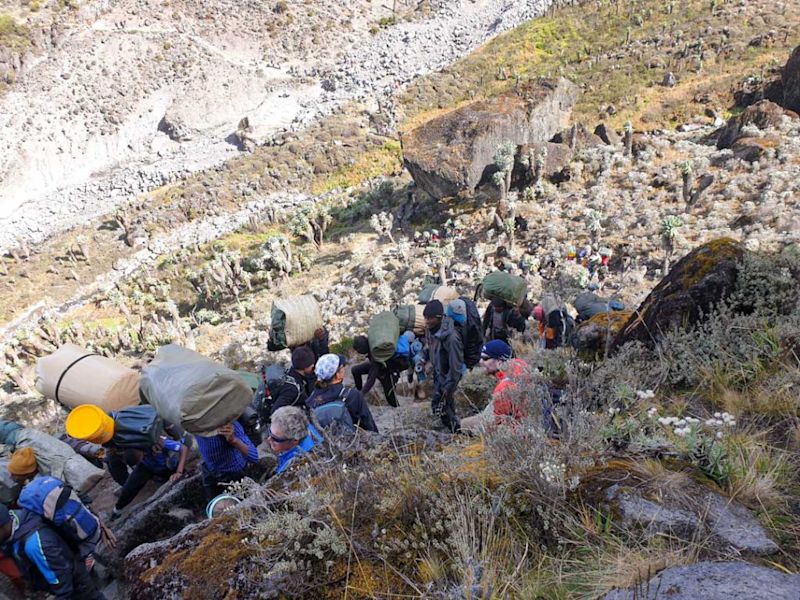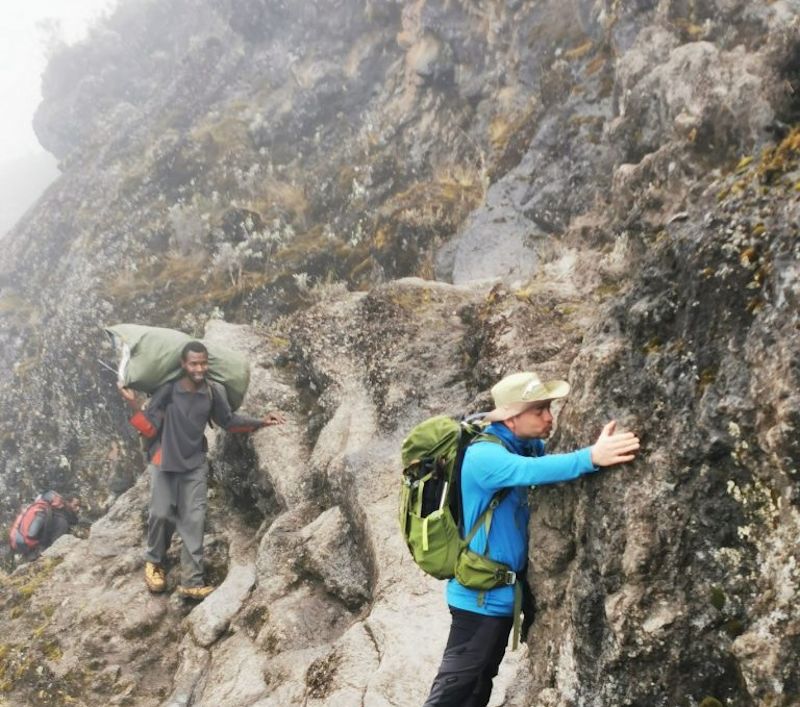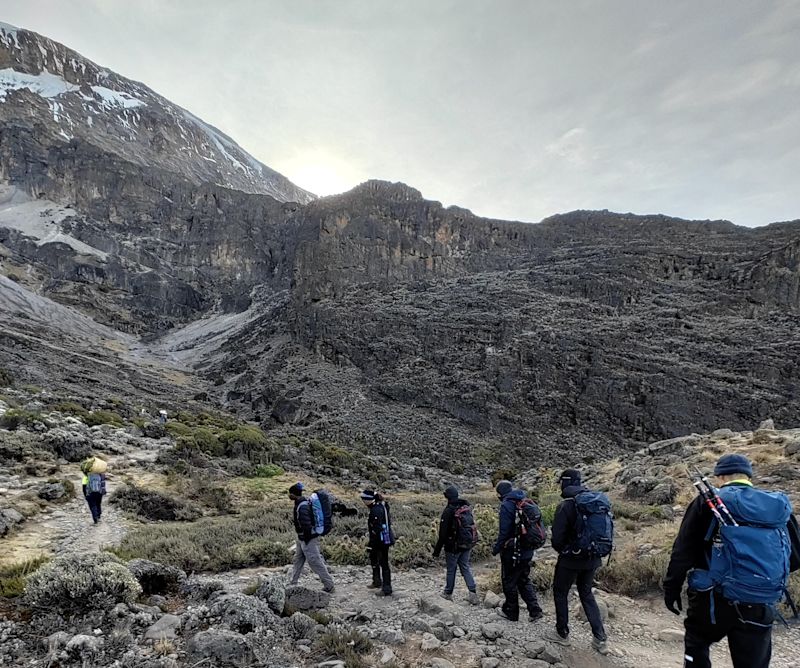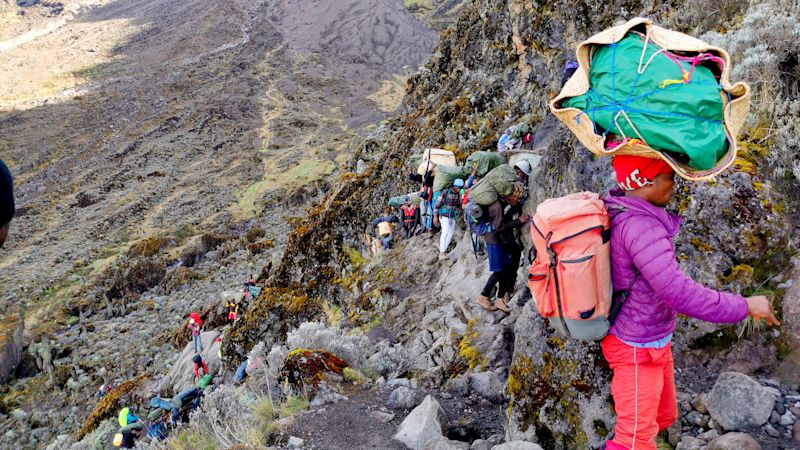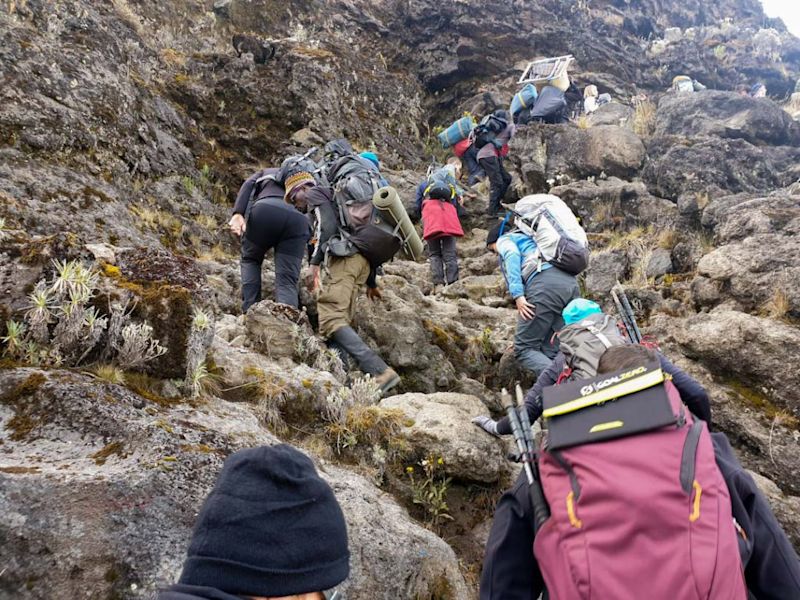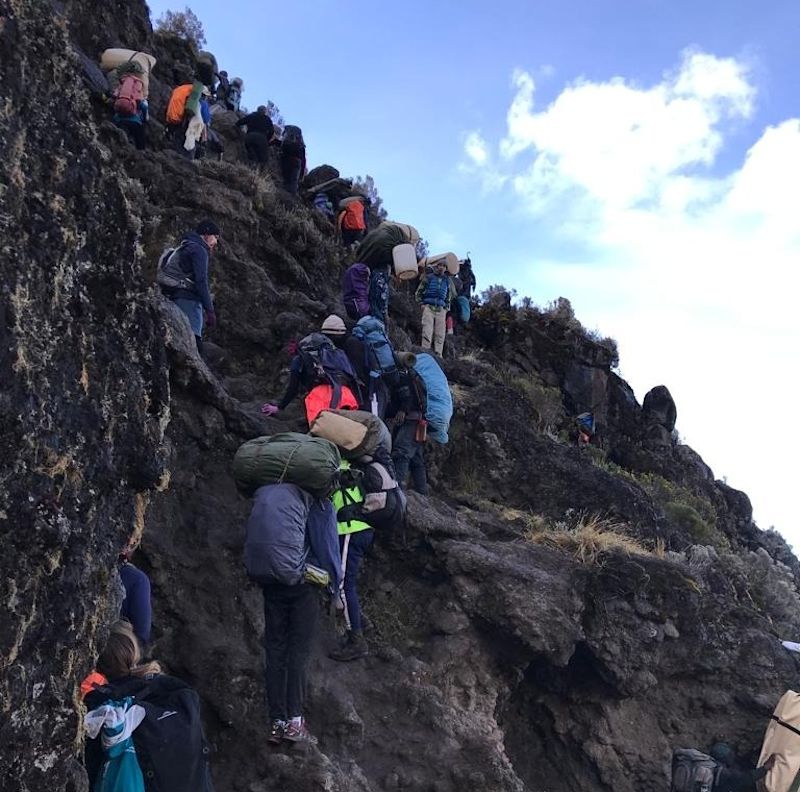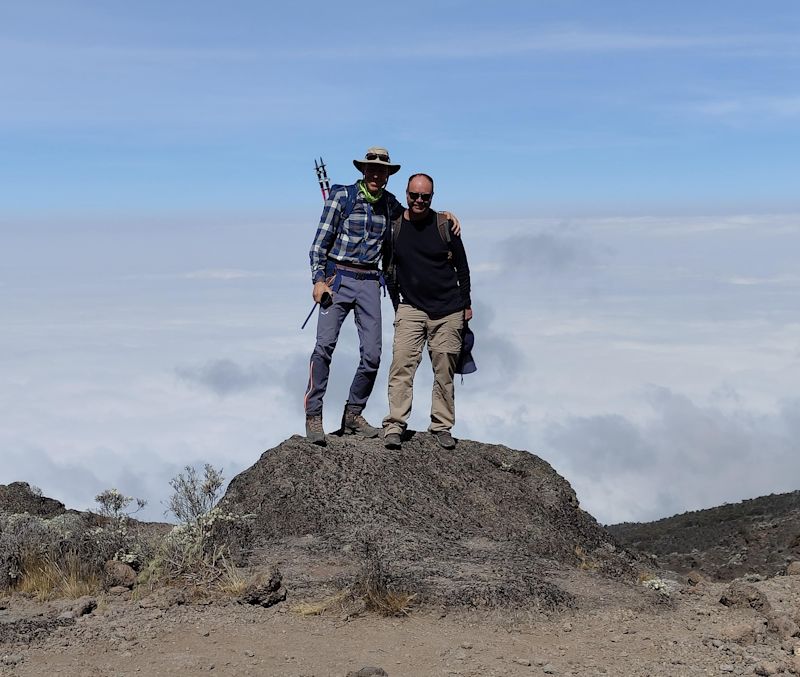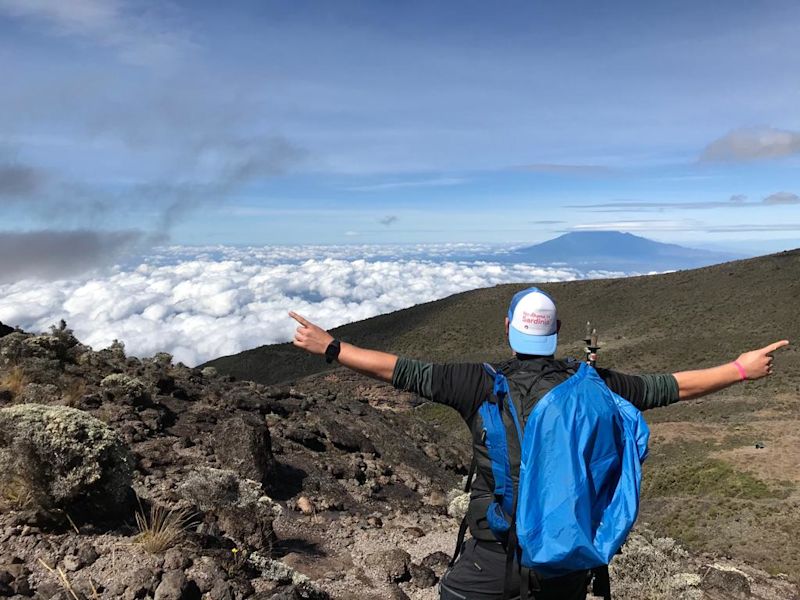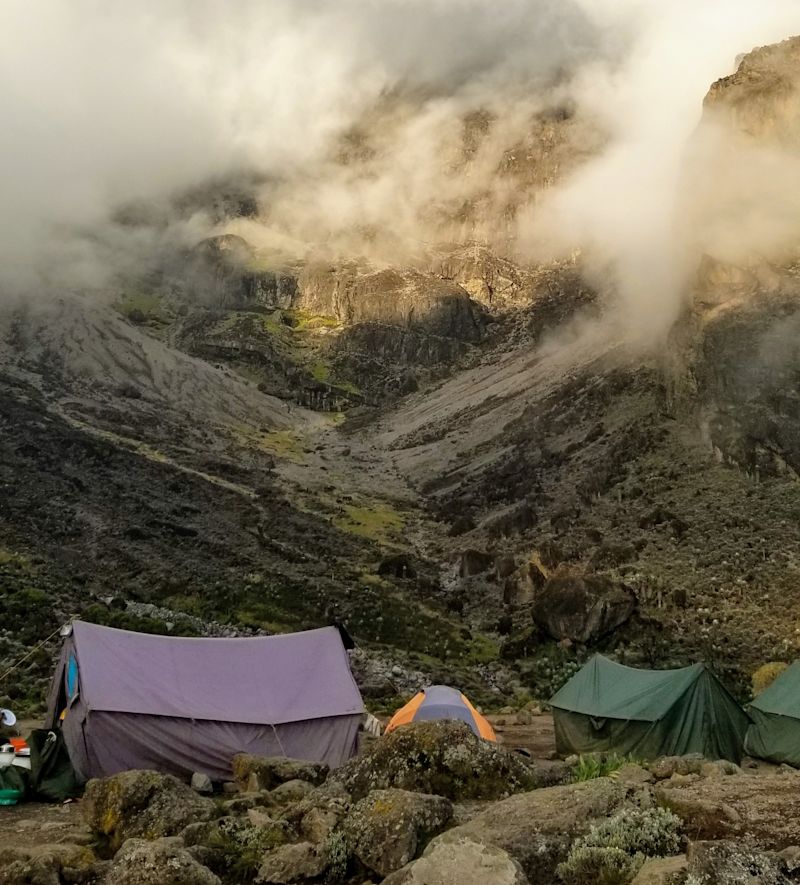The Barranco Wall on the southern slope of Kilimanjaro is one of the most famous and challenging aspects of the whole mountain.
In fact, it's such an impressive and imposing feature of Mt Kilimanjaro that it's often referred to as the Great Barranco Wall.
A section of the path up Barranco Wall
What is the Barranco Wall?
The Barranco Wall is a steep ridge about halfway up the southern slope of Kilimanjaro.
From a distance, the Barranco Wall looks like a wall of rock, hence its name. You can see the 'wall' in the photo below ...
Our client Frederik took this pic of his group walking towards Barranco Wall
However, up close, the Barranco Wall is much easier to climb than you might imagine. There’s even a well-trod, zigzagging path that leads up it.
Far from being a vertical wall or cliff face, the Barranco Wall is actually a steeply sloped, solidified tumble of rocks dotted with bits of earth and vegetation. In many places you can simply walk the path, though in others you’ll need to use your hands – and maybe knees – to scramble up.
The Barranco Wall was formed long ago when Kilimanjaro was an active volcano. A massive landslide deposited a mess of large rocks on the portion of the mountain that is now Barranco Wall.
Where is the Barranco Wall?
The Barranco Wall is on the south side of Mt Kilimanjaro. You scale it after spending a night at Barranco Camp, which is usually on Day 3 or 4 of your climb.
As discussed below, only four of the seven Kilimanjaro routes take you up Barranco Wall. The other three routes wend their way up different sides of the mountain at this elevation.
Looking back down Barranco Wall
How high is the Barranco Wall?
The Barranco Wall is just 257 m from base to top. Many people think of it as being more than that. But as with many natural features, the Barranco Wall looks more treacherous and intimidating from far away than it when you're actually on it.
All that said, it’s still an impressive feature that takes some guts to scale! But it’s not quite as fearsome as many conjure in their minds before encountering it in person.
There are no places on the wall, for instance, where you need chain ladders or anything of the sort. The Barranco Wall just requires a few big steps and at times for you to take hold of the rocks around you for extra balance and leverage.
How bad is the wall if you’re terrified of heights?
A section of the Barranco Wall
At first blush the Barranco Wall looks intimidating, but it's really not that difficult or steep once you're on it.
Also, please note that at no point on the Barranco Wall do you find yourself teetering over a precipice. It’s a steep mountainside climb that’s a jumble of rocks and vegetation – it’s not a cliff. At points you’ll be using your hands and maybe even knees to do some scrambling, but that’s it. We've never had anyone turn back from the wall climb, saying it's too scary – everyone manages!
That said, if you are someone with a real phobia of heights, then we might suggest you take a different route up Kilimanjaro so as to avoid the Barranco Wall. We discuss the different route options below.
The only part of the Barranco Wall that requires some real focus to avoid falling is the Kissing Rock ...
What is the Kissing Rock?
Matthieu about to plant one on the Kissing Rock!
There’s a section near the top of the Barranco Wall where the path narrows and you have to hold onto the rock known as the Kissing Rock to move on safely. It’s called the Kissing Rock because you hug it so closely that you could easily just plant a kiss on it. Most do!
The Kissing Rock is the trickiest and most often the scariest part of the Barranco Wall climb. But as with everything, if you take it slowly and carefully, you'll be 100% okay!
How long does it take to climb?
En route to climb the wall
It usually takes trekkers about one to two hours to climb the Barranco Wall.
Take note that the trail up the wall is narrow, and it must be walked in single file. The Barranco Wall therefore funnels all trekkers into a line. This means that some will advance up the wall slower than they might if nobody was ahead of them.
But Kilimanjaro isn’t a race, and if you’re forced into a standstill, embrace the time to enjoy the epic view!
All that said, there are points where you can pass a climber. Just be careful and courteous about it.
Note that the porters will often be passing you, but they usually do so by walking off the trail along sections that most of us mere mortals would consider complete no-go’s! Kilimanjaro porters are wizards!
Porters on the Barranco Wall showing how hardcore they are!
The community spirit of the Barranco Wall
Barranco Wall, as mentioned above, funnels everyone trekking four of the seven Kilimanjaro routes onto a single path. This makes it one of the most crowded spots on the mountain.
But don't let the word crowded bum you out. Because the camaraderie that emerges as everyone climbs the wall together is actually something very special. Oftentimes people sing, and there's a sense of being part of a very big team climbing the mountain. In fact, climbing Barranco Wall is a unique and special moment in your Kilimanjaro adventure that you remember quite specifically.
Climbing the Barranco Wall is never done alone!
Do I need climbing equipment?
No, you don’t need any special equipment to climb Barranco Wall.
Many people climb Kilimanjaro using trekking poles. When you get to the Barranco Wall, you’ll want to stow these so that you have your hands free. Climbing the Barranco Wall involves some scrambling, which is why you don’t want to be encumbered with trekking poles.
Given that the Barranco Wall requires some scrambling, it's important for you to be reasonably flexible to manage it well. If you're a bit older or aren't very bendy, we recommend that you do some flexibility training in addition to your cardio and strength training before the climb. Proper Kilimanjaro preparation is vital to a successful and enjoyable climb.
Also note that since you’ll be using your hands while climbing the Barranco Wall, you might want to don a pair of waterproof gloves at the time. On certain days your hands will otherwise get very cold and wet.
And up and up we go, taking it pole, pole (slowly, slowly)!
Is the Barranco Wall dangerous?
Many who are looking into climbing Kilimanjaro want to know if the Barranco Wall is dangerous. Quite rightly. The good news is that it’s not nearly as dangerous as one might fear after seeing photos from certain angles.
Further to this, if you take it pole, pole (slowly, slowly) and concern yourself only with your own progress, as your Kilimanjaro guides will advise, you’ll be just fine.
Celebratory photo at the top of Barranco Wall!
What do past climbers say about the wall?
Salwan has the following to say of Barranco Wall:
You get some incredible views and as most of the trip so far has been open, ‘flat’ landscape, so it’s really nice to be on higher cliffs with a drop that gives you a real sense of the height you are at.
Joel says:
For us this was one of the parts where we got even more impressed with the porters. While the hiking groups were going up the wall zigzag the porters just walked straight up with their 20 kg on the head.
Tash says the following of the Barranco Wall:
The Barranco Wall looks intimidating as you walk towards Barranco Camp. You get your first glimpses of it as you pass through the Dendrosenecio kilimanjari trees from Lava Tower. It looks a lot scarier than it actually is. You just need to take your time and be conscious of the porters wanting to get past faster on the narrow path.
And then finally you're standing at the top of the Barranco Wall, revelling in your achievement!
Which routes go via the Barranco Wall?
There are seven routes up Mt Kilimanjaro, and not all take you via the Barranco Wall. If you are very nervous about the wall, you might prefer to trek a route that leads you to the summit a different way.
The Kilimanjaro routes that include climbing Barranco Wall are:
- Lemosho (our favourite route!)
- Machame (also a great option)
- Shira
- Umbwe
And the Kilimanjaro routes that take you up the mountain without the need to scale Barranco Wall are:
- Marangu
- Rongai
- Northern Circuit (a fantastic route)
You overnight at Barranco Camp before climbing Barranco Wall
Still have questions about the Barranco Wall?
Drop us a line and we'll call or text you back and we can chat through it all with you. Climbing Kilimanjaro is an absolutely epic adventure – we don't want anything to stand in your way of taking on this fantastic mountain adventure!


